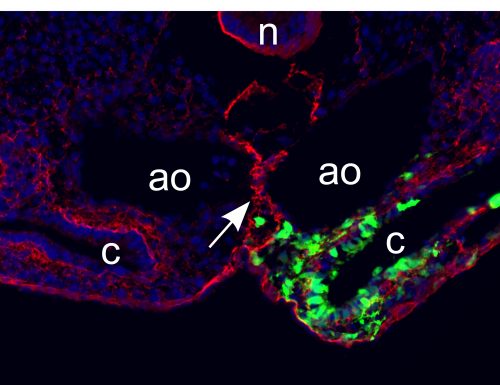New discoveries regarding the development of the abdominal midline around which the heart, lungs and digestive system form in the fetus are published in the journal Developmental Cell. The research was conducted by Prof.-member Tom Schultheiss and Ph.D. student Alaa Araf from the Rappaport Faculty of Medicine at the Technion

Research conducted at the Rappaport Faculty of Medicine at the Technion sheds light on the formation of the front of the body during embryonic development. In the study, published in the journal Developmental Cell, Professor Tom Schultheiss and doctoral student Alaa Araf examined the factors responsible for the development of the ventral (front) midline parallel to the dorsal (back) midline.
According to Prof. Schultheiss, "Unlike the dorsal midline and the spine, which have been studied from many different aspects, the development process of the abdominal midline is not clear. This is despite the importance of this line, on and around which the heart, navel, genitals, aorta, digestive system, sternum, bladder, liver, pancreas, lungs and more are formed."
"The development of the dorsal midline precedes the development of the abdominal midline," explains Araf. "That's why it's important that the abdominal line develops in coordination with the back. A disruption in this process causes a mismatch between the back area and the abdominal area and may harm the development of organs such as the heart and lungs and even lead in some cases to the death of the organism."
In the current study, the researchers examined the cellular and molecular mechanisms responsible for the formation of the abdominal midline in the early stages of fetal development. One of the key factors in the control of the said process is the BMP (Bone Morphogenic Protein) gene, and according to Araf, "It turns out that the control of BMP from a central source (the spinal cord) enables the precise timing and coordination in the creation of the abdominal midline. An unbalanced expression of BMP will lead to a lateral deviation of the abdominal midline, which may cause problems in the further development of the internal organs in the abdominal and thoracic region."
The research published in Developmental Cell was conducted in collaboration with Andreas Kispert from the Institute of Molecular Biology at the Medical School in Hannover, Germany.
In the laboratory of Prof. Schultheiss, the development of the fetus is studied with an emphasis on the beginning of the organization of the body and the building of the organs. "The practical goal of these fields is to produce tissues in the laboratory that will be successfully transplanted into damaged organs," explains Prof. Schultheiss. "For this, a thorough understanding of the formation of the tissue in the natural process of fetal development is required. That's why we study the formation of the organs in the first stage, in which the embryonic cells acquire specific characteristics suitable for the target tissue (bone, skin, etc.), as well as in the following stages, in which the various cellular components combine to form a functioning organ."
